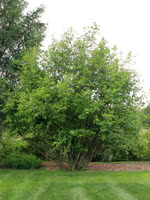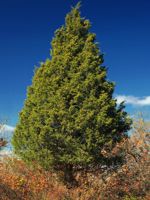Mon-Fri 9am - 5pm Mountain time
Green Alder vs Eastern Red Cedar
Alnus alnobetula subsp. crispa
Juniperus virginiana
NOT AVAILABLE THIS SEASON - MIGHT RETURN
Green Alder is a native, cold-hardy shrub found in boreal forests, along slopes, and in open upland habitats. It fixes nitrogen in the soil, improving fertility and helping other plants grow, while its roots help stabilize slopes and disturbed ground. Fast to establish on poor soils, it is widely used in reclamation, restoration, and erosion control projects.
With its smooth grey bark and shiny green leaves, Green Alder often forms dense thickets that provide cover for birds and small mammals. Its seeds, buds, and catkins also supply food for wildlife. Green Alder is well suited for naturalization and ecological restoration.
Note: We use Green Alder for Alnus alnobetula subsp. crispa. This species is also known by many other common names, including Mountain Alder, Sitka Alder, and others. Please confirm the scientific name to ensure you are ordering the correct plant.
Eastern Red Cedar is native to eastern Canada and is actually a variety of juniper, not cedar. Its pyramidal crown, low hanging branches, and dense, compact foliage makes it an ideal windbreak or shelterbelt tree.
Eastern Red Cedar will attract wildlife to your yard and provide food and shelter for multiple varieties of birds. If you are on the east coast looking to create a windbreak, consider Eastern Red Cedar.
Green Alder Quick Facts
Eastern Red Cedar Quick Facts
In row spacing: 0.9 m (3 ft)

